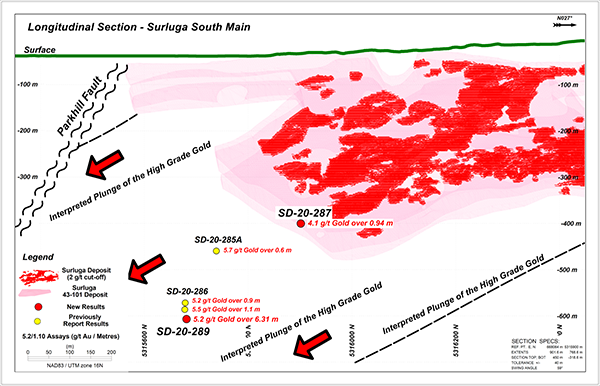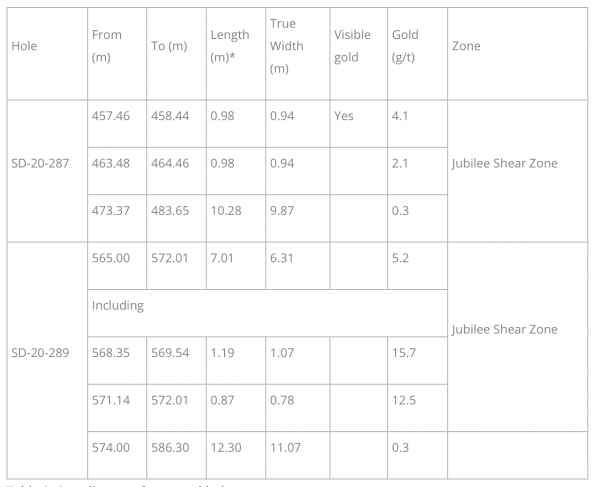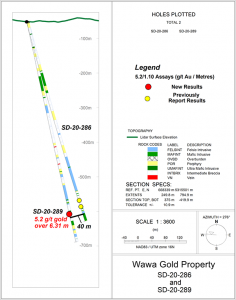Red Pine Exploration Inc. announces the discovery of a new mineralized gold zone, beneath the Surluga Deposit1, during its on-going exploration program at its Wawa Gold Project, located 2 kilometres southeast of Wawa, Ontario. Hole SD-20-289 successfully intersected the Jubilee Shear Zone (host of the Surluga Deposit), 350 metres down-plunge of the current resource boundaries, with a significant intercept of 5.2 g/t gold over 6.31 metres (true width) at a depth of 570 metres. Hole SD-20-287 intersected 4.1 g/t gold over 0.94 metres (true width) below 450 metres depth.
These new drilling results indicate that high-grade gold mineralization extends at depth, well beyond the footprint of the current resource of the Surluga Deposit, and that the resource can be expanded (Figure 1).
The 2020 exploration program is funded and drilling is expected to restart in the next 2 weeks. Remaining drilling assays from the Winter 2020 program and results of the upcoming down-hole IP survey will be announced as they are received.
Quentin Yarie, Chief Executive Officer of Red Pine stated, “Following the results from holes 285A and 286, today’s results from hole 289 represent more definitive evidence that the higher-grade core of the Surluga Deposit extends well beyond the footprint of the current resource. Finding this extension, early in our exploration program, validates the accuracy of our predictive modelling of the Jubilee Shear Zone. Our next holes will test the area up- and down-plunge of this discovery to quantify the extension and grade of the discovery in hole 289. Targeting will be supported by the interpretation of the borehole IP geophysical program that is starting this week.”
Holes SD-20-287 and SD-20-289 were targeting the down-plunge extension of the southernmost limit of the Surluga Deposit resource.
Hole SD-20-287 intersected a large diabase dyke in the upper 20 metres of the Jubilee Shear Zone. The higher-grade gold results came from a 0.7-metre quartz vein in which specks of visible gold were observed. A 10.28 metre-wide halo of low-grade gold mineralization characterized by spaced quartz veins, disseminated pyrite, and weak-moderate biotite/sericite was intersected in the Jubilee Shear Zone, further down-hole of the diabase dyke.
Hole SM-20-288 was testing the expected limits of the projected plunge of the Surluga Deposit resource. No zones of strong alteration or mineralization were observed in that hole.
Hole SD-20-289 intersected gold 40 metres away from the gold intercept in Hole SD-20-286 (Figure 2). In the Jubilee Shear Zone, it hit a 7 metres zone characterized by stronger quartz veining associated with pervasive dissemination of pyrite, locally arsenopyrite, and moderate to strong biotite/sericite alteration. The upper part of the zone is cut by a 4 metre-wide lamprophyre dyke. High-grade gold mineralization is associated with alteration assemblages variably comprised of biotite/sericite-quartz veining-pyrite and sericite-quartz veining-arsenopyrite. A 12.3 metre-wide halo of low-grade gold mineralization characterized by spaced quartz veins, disseminated pyrite, and weak-moderate biotite/sericite alteration is located below the higher-grade zone in SD-20-289. Below the Jubilee Shear Zone, a new shear zone was intersected with pyrite mineralization and spaced quartz veining. Assays are pending for that shear zone and will be released when received.
- Red Pine Updates on its 2022 Phase 1 Drill Program – Expands Drill Program - January 6, 2022
- Red Pine Intersects 3.08 g/t Gold over 55.66m at Wawa Project - November 9, 2021
- Red Pine Makes New Discovery at Surluga Deposit - May 13, 2020
 Wawa-news.com You can't hear the 'big picture'!
Wawa-news.com You can't hear the 'big picture'!



